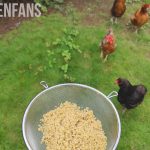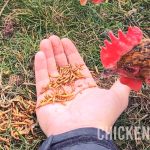Sprouting Grains For Chickens: How And Real-Life Testing
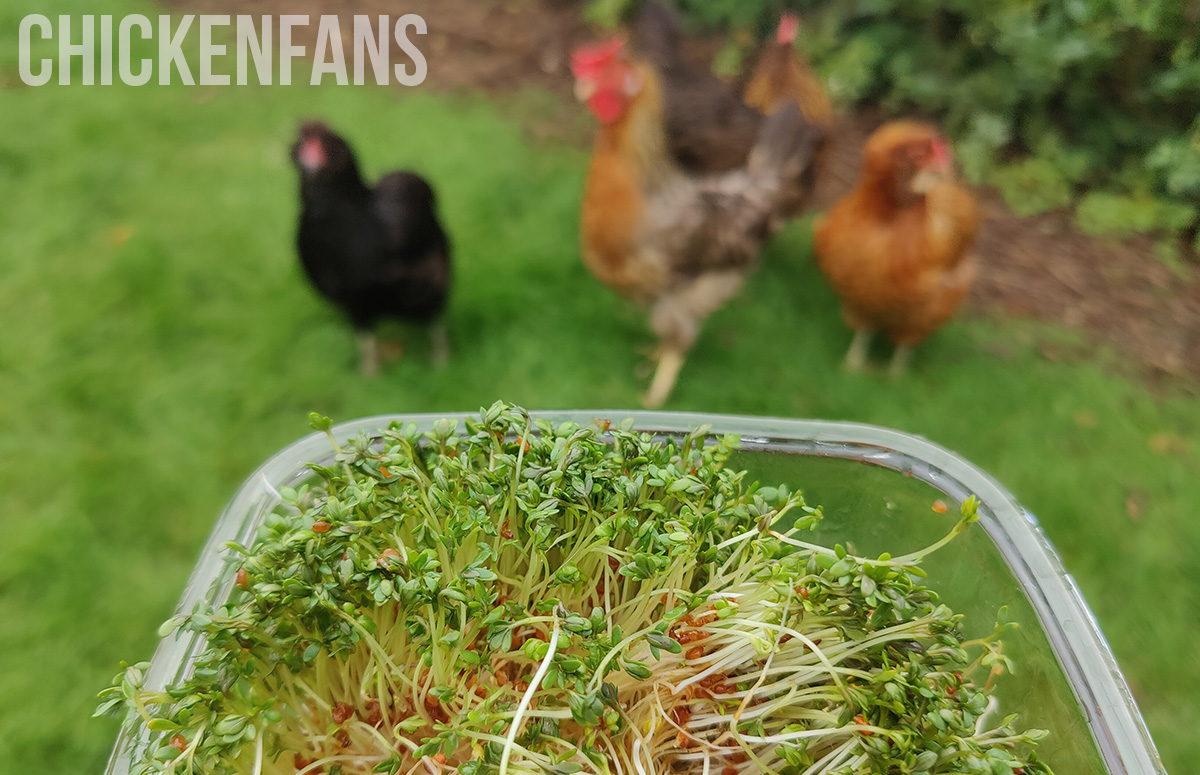
Caring for chickens brings much freedom and flexibility. While prioritizing their safety, health and nutrition, winter season may pose a challenge due to its limited foraging. Here’s where sprouting grains for your flock comes in. Despite seeming complex, it’s quite manageable for smaller flocks and your chickens will love it.
Let’s dive into the benefits and process of sprouting grains for your chickens.
Is Sprouting Grains for Chickens Worthwhile?
Certainly. While sprouted grains are not a complete replacement for their diet, it effectively supplements your chickens’ feed, especially during winter. Sprouts are very nutritious and should make up 10 to 15% of their daily intake and are easily made right on your kitchen counter.
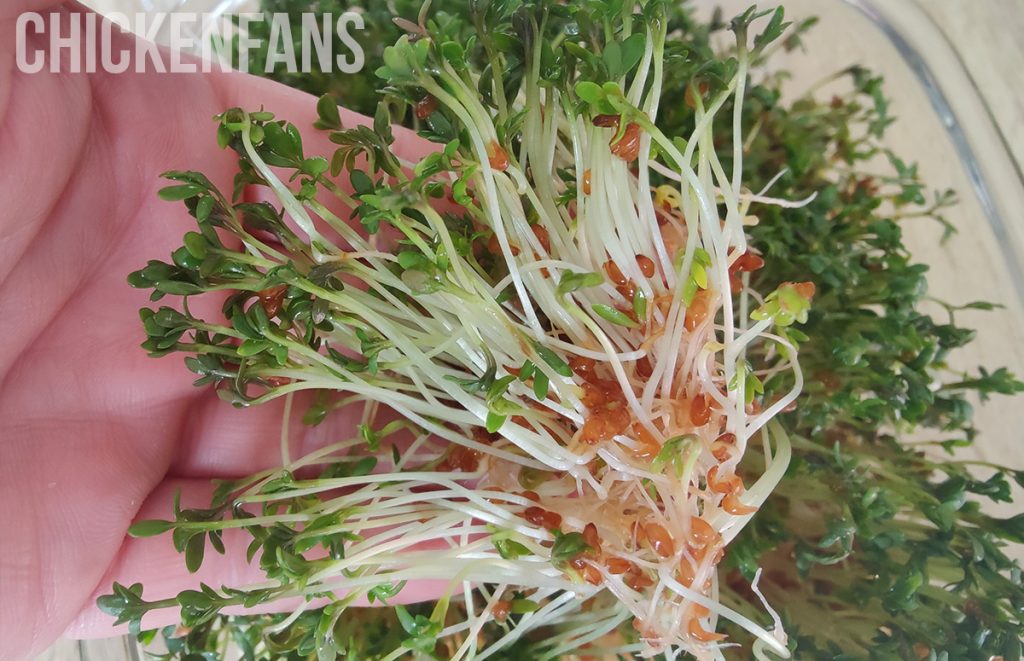
Benefits of Sprouting Grains for Your Chickens
So, what makes sprouting grains for chickens such a good idea? Here are the main benefits to keep in mind:
Year-round greens – sprouting grains for your chickens ensures that you have a year-round supply of fresh greens for your chickens. This is especially crucial during cold winters but can also be great during heatwaves or dry summers.
Entertainment – being quite intelligent, chickens can get bored quickly, especially when they need to stay locked up all winter. Giving them sprouted grains is good entertainment as eating them is more engaging than just pecking at standard chicken feed. Let’s see how interesting they find it to eat sprouted grains:
Enhanced digestion – sprouts aren’t just more easily digestible than grains; they also improve the whole digestive health of poultry birds.
Nutrient boost– sprouts are more nutritious than grains and seeds as the purpose of the entire sprouting process is to take nutrients outside of the seed’s protective casing and sprout them into life. This doesn’t mean chickens should eat sprouts only – grains are still a key part of their diet. But mixing in sprouts guarantees a healthier and more nutritious diet.
Affordability – sprouting grains for chicken is surprisingly affordable as the whole process doesn’t take much. All you need is some seeds or grains, a container, a bit of water, and time. We’ll explain the whole process in more detail below. But suffice it to say that this isn’t an expensive chicken feed supplement.
Human benefits – people can eat sprouted grains too and can get the same benefits out of them as chickens do. Humans and chickens alike benefit greatly from adding more iron, Vitamin C, magnesium, folate, zinc, and protein into their diets, and sprouts do precisely that. So, while sprouting grains for your flock, you can easily take some and sprinkle them on your salad.
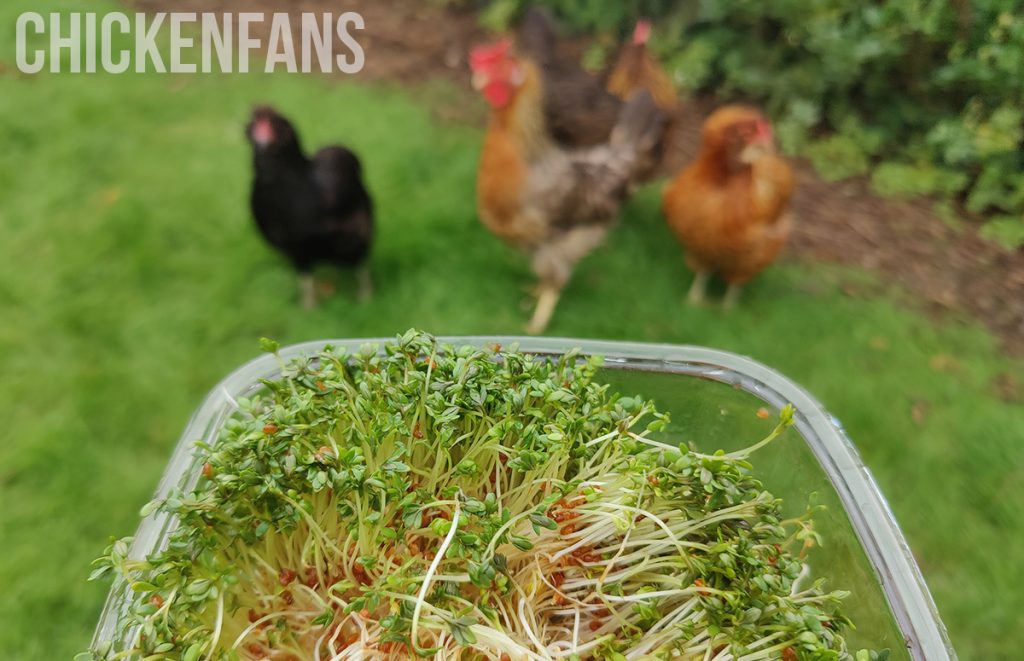
Which Grains are Best to Sprout?
The options for sprouting are almost limitless when you consider the countless different types of grains and seeds out there. The two most commonly sprouted grains for chickens are wheat and barley; however, other great options include alfalfa, sunflower seeds, cress (as we used), soybeans, oats, clover, broccoli, radish, mung beans, lentils, and others.
Ideally, we’d recommend changing the grains you sprout once every few batches to keep your chickens interested. More importantly, trying out different types of seeds and grains will tell you which you prefer to sprout too as every plant has its specifics.
For example, sprouting sunflower seeds leaves the seeds’ casing on top of the sprout, almost like a black cap. A lot of people don’t like that when they sprout sunflower seeds for themselves as each seed casing needs to be removed. For chickens, however, this isn’t an issue and even makes pecking at the sprouts more entertaining.
Overall, the “best” grains to sprout would be whichever ones of the above you enjoy sprouting and your chickens like eating, as all of the commonly sprouted sorts are very rich in vitamins and nutrients.
How about Seasonal Differences?
Which sprouts are best in the winter, and which are ideal for the summer?
There isn’t much of a difference between the grains you should sprout in the winter or the summer. The nutritional needs of chickens don’t change much between the seasons – all that matters is that you maintain a good nutritional diet all year-round.
In that sense, sprouting grains for your chickens is much more important in the winter than it is in the summer. However, you don’t really need to change the types of sprouts you grow based on the season.
What’s the Difference Between Sprouts and Fodder?
Sprouts are early growth stages of grains or seeds, lasting about 5 to 6 days. Fodder is the subsequent stage around day 6 when they reach around 4 inches. Fodder is less nutritionally dense, requires a different setup for mold prevention, and takes longer to grow, offering greater volume over higher nutrition.
Let’s debunk a common misconception regarding sprouts and fodder. Although these terms are often used interchangeably, they hold an important distinction – fodder represents the subsequent growth stage of sprouts.
In short, the focus of this article is sprouts, not fodder. Although fodder provides more sustenance, it’s less nutritionally dense and shouldn’t replace standard chicken feed.
How to Sprout Grains?
Fortunately, sprouting grains is exceptionally easy. All you need is some open space on the kitchen counter with at least a bit of sunlight, the seeds or grains you’re interested in sprouting, and a couple of wide and flat containers.
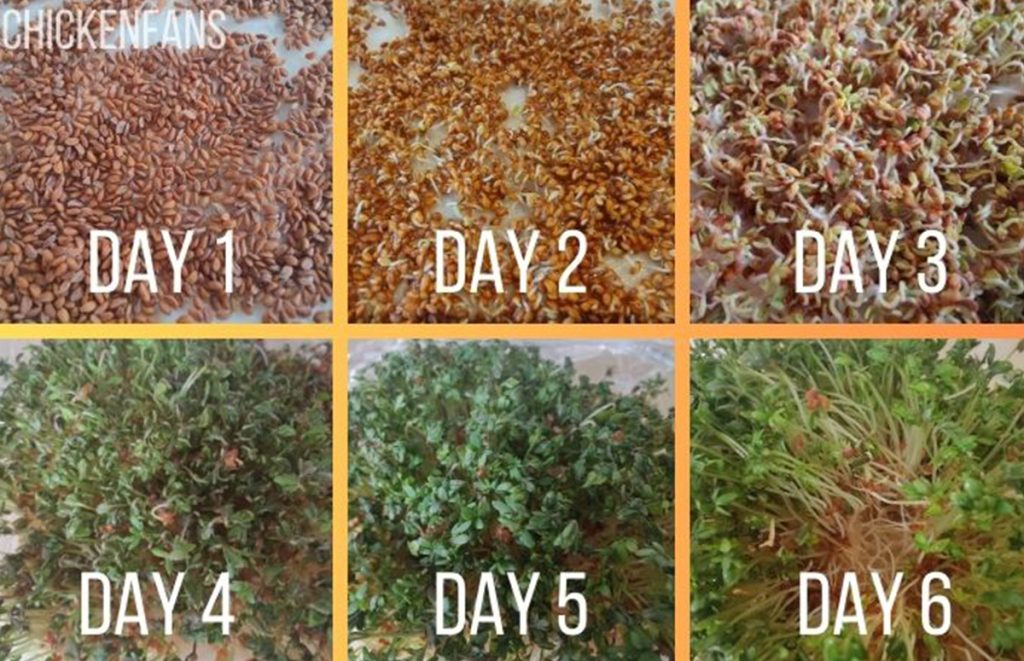
Here’s the step-by-step process to follow:
Time needed: 6 days
How-To Process of Sprouting Grains for Chickens
- Buy quality grains
Make sure that you’ve gotten the grains you want from an adequate source. Don’t just use grains from commercial chicken feed, as those aren’t good for sprouting. Instead, look for grains and seeds for sprouting from health stores, chicken feed stores, or good online stores. Such places guarantee the grains are fresh and haven’t been treated.
- Soak the grains in water overnight
Soaking helps to quickly wash away the protective natural chemicals on the outside of the grains and begin the sprouting process. Some people skip this step, and that’s ok – the sprouting process will just take a little longer if you don’t soak.
- Prepare the container
Take a wide and flat container such as a tray and pinch some holes in the bottom. The holes should be wide enough for water to drip through them but narrow enough for the grains and seeds to stay in the tray. The holes can be just on the periphery of the tray or all throughout it. You can buy a special sprout growing tray online, but any container in your kitchen can do the trick too.
- Set the container over another container
That way, when water is dripping from the sprout tray, it will have a place to fall into.
- Place at room temperature
Set up the whole system somewhere indoors at room temperature (between 70 and 80F) and sufficient sunlight. Make sure that there’s at least minimal ventilation in the space too to avoid mold from forming from the extra humidity.
- Add water to the grains
Start spraying the grains with water two or three times a day. Use a standard spray bottle filled with clean, fresh water, preferably filtered rainwater or bottled water, as tap water can be too harsh. Remember to empty the water container underneath the sprout tray if it gets full.
- Monitor for the next few days
Monitor the length of your sprouts – they should reach around 4 inches on the 5th or 6th day. You should remove them after that point, package them into boxes, and put them in the refrigerator.
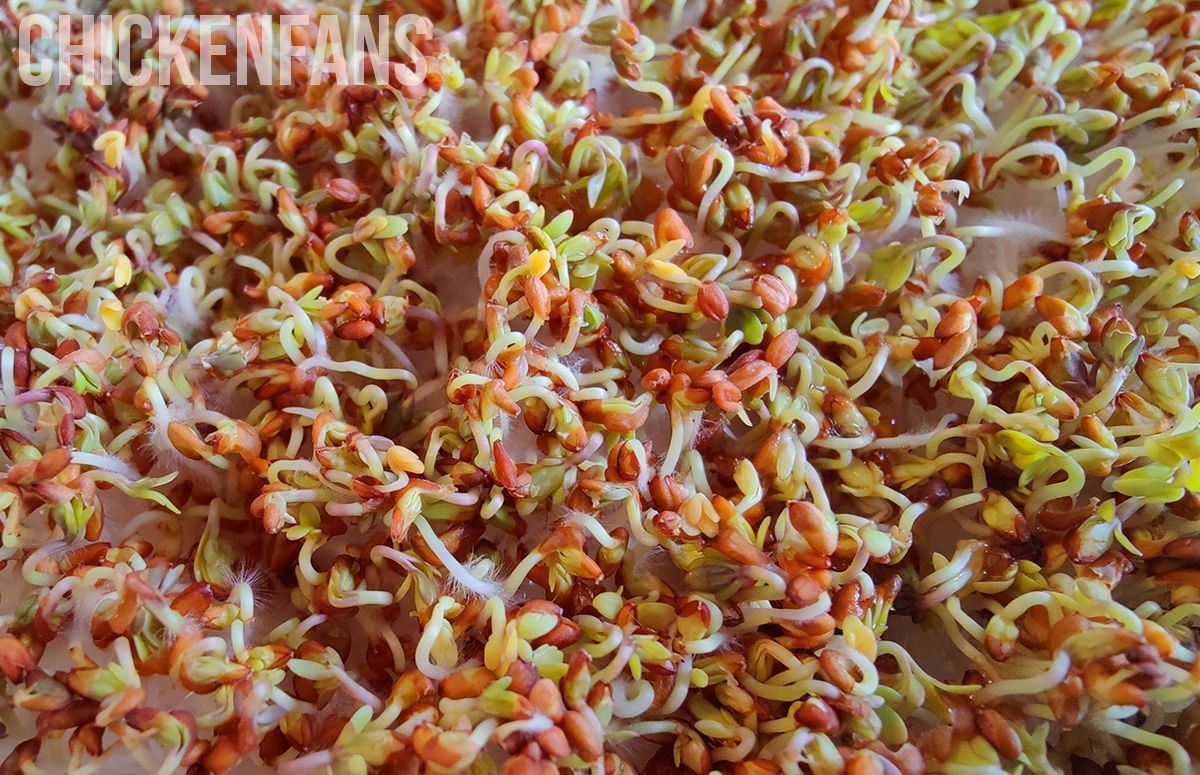
- Feeding time!
At this point, you can feed the homegrown sprouts to your chickens. Remember to clean the sprouting tray after each growth cycle.
And that’s about it – with a bit of space in your kitchen you can grow plenty of sprouts for your chickens every week.
Sprouting Grains as a Part of a Self-Sufficient Life
Sprouting grains for chickens is a big part of self-sufficient living for many chicken keepers. One of the big reasons many people look after chickens, after all, is for the fresh eggs they provide as well as for their meat.
Many people even make their own chicken feed or ferment the feed, although that process is more complicated – and often more expensive – than just growing sprouts. Still, by sprouting grains for your birds, you can make a big step toward self-sufficiency.
The fact that sprouts are also an excellent and nutritional food for humans is another big part of that – by growing greens, veggies, and fruits in your garden, sprouts on the kitchen counter, and egg-laying chickens in the backyard, people can easily satisfy a huge part of their dietary needs.
In Conclusion
Sprouting grains for chickens is something that sounds a bit “extra” for a lot of people, but it’s actually a very easy and smart thing to do.
It barely takes any time and effort, keeps your chickens as healthy and happy as possible, supplements their diet, and can be a healthy addition to your family’s salads too.
So, whether you choose to go with barley, wheat, broccoli, sunflower seeds, clover, lentils, mung beans, or any other standard sprout options out there, you should give sprouting a go.


